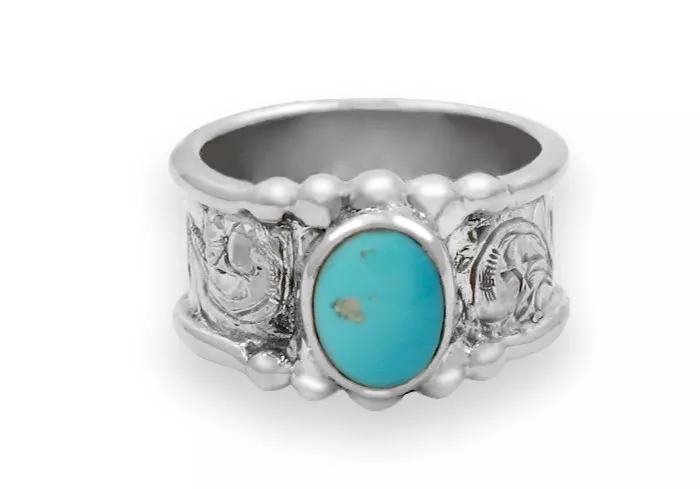Turquoise is a stunning gemstone with a rich history and cultural significance. However, not all turquoise jewelry is genuine. Many rings on the market are made from fake or treated materials. If you’re wondering, “Is my turquoise ring real?”, this guide will help you determine its authenticity. We’ll cover how to spot real turquoise, common imitations, and simple tests you can perform at home.
What Is Real Turquoise?
Turquoise is a natural gemstone formed over millions of years. It is a hydrous phosphate of copper and aluminum, which gives it its famous blue-green color. Real turquoise is prized for its unique veining (called “matrix”) and its waxy, slightly porous texture.
Key Characteristics of Real Turquoise:
Color: Ranges from sky blue to greenish-blue, depending on copper (blue) and iron (green) content.
Matrix: Natural veins or web-like patterns (usually black, brown, or gold).
Texture: Slightly rough or porous, not perfectly smooth.
Hardness: Between 5 and 6 on the Mohs scale (softer than quartz but harder than glass).
Common Fake Turquoise Materials
Many rings sold as “turquoise” are actually imitations. Here are the most common fake turquoise types:
Howlite or Magnesite (Dyed “Turquoise”)
Howlite is a white stone with gray veins.
It is often dyed blue to mimic turquoise.
The dye can fade or rub off over time.
Plastic or Resin (Man-Made Fake Turquoise)
Lightweight and feels artificial.
No natural imperfections or matrix.
Often too uniform in color.
Reconstituted Turquoise (Crushed & Rebuilt)
Made from low-quality turquoise dust mixed with resin.
Lacks natural veining or has fake, painted matrix.
Less valuable than solid natural turquoise.
Glass or Ceramic Imitations
Too smooth and shiny compared to real turquoise.
May have air bubbles (a sign of glass).
Harder and colder to the touch than real turquoise.
How to Test If Your Turquoise Ring Is Real
You don’t need a professional to check if your turquoise is real. Here are simple tests you can do at home:
The Scratch Test (Hardness Check)
Turquoise is softer than quartz but harder than glass.
Try scratching a hidden part of the stone with a steel pin.
If it scratches easily, it may be howlite or plastic.
If it doesn’t scratch, it might be glass or ceramic.
The Heat Test (Be Careful!)
Real turquoise is heat-resistant.
Hold a heated needle (not too hot) near an inconspicuous spot.
If it melts or smells like plastic, it’s fake.
Real turquoise won’t react to mild heat.
The Water Absorption Test
Turquoise is slightly porous.
Place a drop of water on the stone and wait a few minutes.
If the water soaks in slightly, it may be real.
If it beads up (like on plastic or glass), it’s fake.
The Weight Test
Plastic and resin fakes feel lightweight.
Real turquoise has a solid, slightly heavy feel.
Glass imitations feel unnaturally cold and heavy.
The Magnifying Glass Inspection
Look closely at the stone under bright light.
Real turquoise: Natural color variations and matrix.
Fake turquoise: Too perfect, with painted-on veins.
The Acetone Test (For Dyed Stones)
Soak a cotton swab in acetone (nail polish remover).
Rub it gently on a hidden part of the stone.
If color comes off, it’s dyed howlite or magnesite.
Real turquoise won’t lose color.
Professional Verification: When to See a Gemologist
If you’re still unsure, a professional gemologist can confirm authenticity. They use tools like:
UV Light: Some fake turquoise glows under UV light.
Microscope: Reveals natural vs. artificial patterns.
Refractometer: Measures how light bends in the stone.
Why Does Real Turquoise Matter?
Durability: Fake turquoise cracks or fades over time.
Value: Real turquoise increases in worth; fakes do not.
Energy & Meaning: Many believe real turquoise has spiritual benefits.
How to Care for Real Turquoise Rings
If your ring is genuine, proper care will keep it beautiful:
Avoid chemicals (perfume, lotion, cleaning products).
Store in a soft pouch to prevent scratches.
Clean with a dry cloth—never soak in water.
Conclusion
By following these tests, you can determine if your turquoise ring is authentic. Real turquoise has natural imperfections, a slightly porous texture, and a unique matrix. Fake turquoise often looks too perfect, feels lightweight, or fails simple tests like the acetone or heat check.
If you love your ring, knowing it’s real adds to its beauty and value. If it turns out to be fake, now you know what to look for in your next turquoise purchase!
Would you like help identifying a specific turquoise piece? Feel free to ask more details!
Related topics:
How Can I Tell if My Turquoise Is Real
Benefits of Wearing Spiny Oyster Turquoise
Where to Buy Authentic Bohemian Turquoise Jewelry Online


